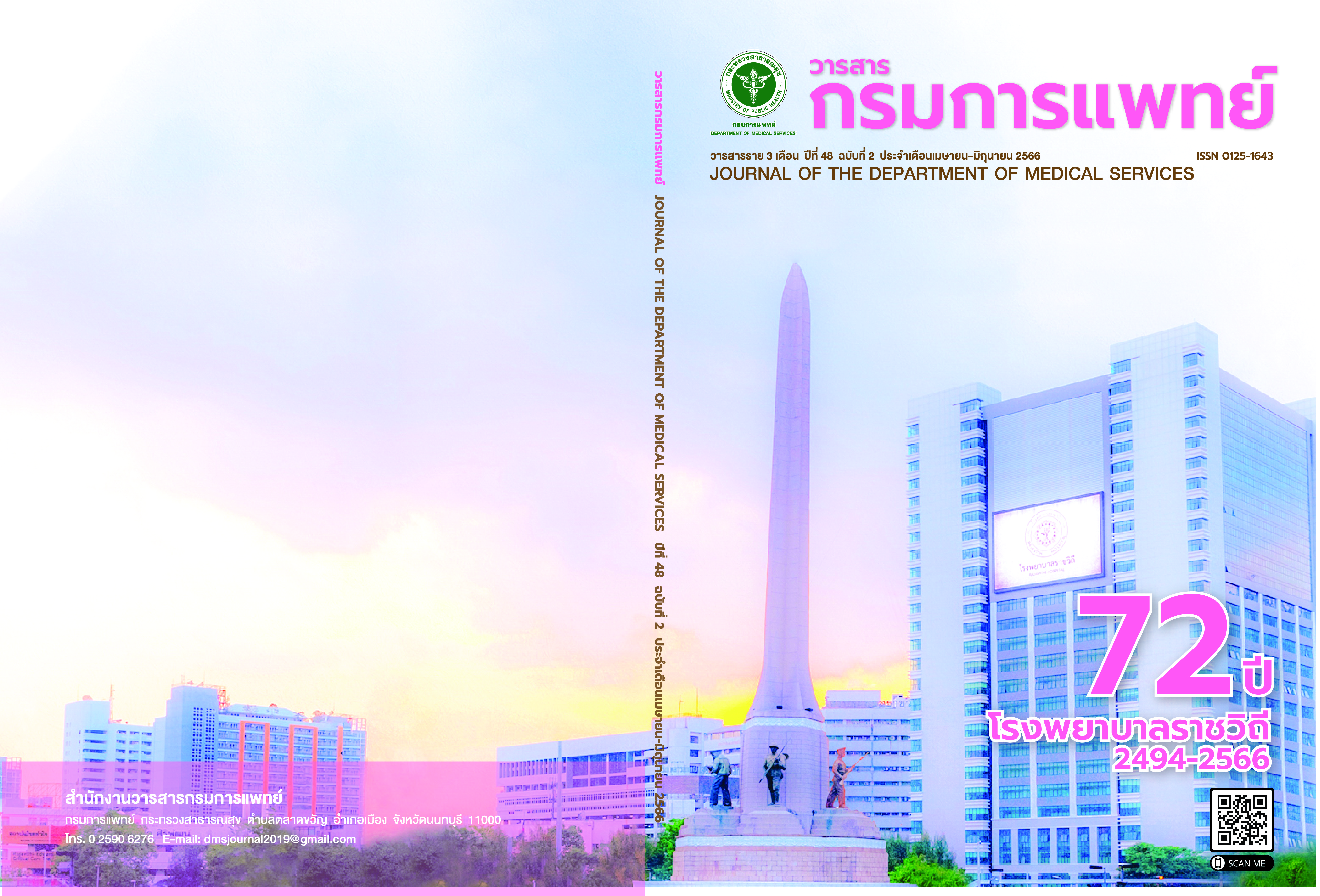การประเมินทางเศรษฐศาสตร์ของการใช้สารสกัดกัญชาชนิดซีบีดีสูงในการรักษาโรคลมชักดื้อยาในเด็ก
DOI:
https://doi.org/10.14456/jdms.2023.31คำสำคัญ:
การรักษาโรคลมชักดื้อยาในเด็ก, สารสกัดกัญชาชนิดซีบีดี, การประเมินทางเศรษฐศาสตร์บทคัดย่อ
ภูมิหลัง: โรคลมชักดื้อยาหมายถึง โรคลมชักที่รักษาด้วยยากันชัก 2 ตัวแล้วไม่สามารถหยุดชักได้ ซึ่งพบประมาณร้อยละ 30 ในผู้ป่วยโรคลมชัก ถึงแม้ว่าสารสกัดกัญชาจะมีหลักฐานว่ามีประสิทธิผลในการลดชักในผู้ป่วยโรคลมชักดื้อยาในเด็ก แต่ความคุ้มค่าของสารสกัดกัญชานี้ยังไม่ชัดเจน วัตถุประสงค์: เพื่อประเมินความคุ้มค่าของสารสกัดกัญชาชนิดซีบีดีสูงในโรคลมชักดื้อยาในเด็ก วิธีการ: วิเคราะห์ต้นทุน-อรรถประโยชน์ โดยการใช้แบบจำลองมาร์คอฟด้วยมุมมองทางสังคมแบบจำลองถูกพัฒนาเพื่อเปรียบเทียบต้นทุนและปีสุขภาวะ (QALYs) ของการใช้สารสกัดกัญชาชนิดซีบีดีสูงร่วมกับยากันชักกับการรักษาด้วยยากันชักปกติในโรคลมชักดื้อยาในเด็กข้อมูลต้นทุนเก็บรวบรวมจากสถาบันประสาทวิทยาความน่าจะเป็นของการตอบสนองทางคลินิกและค่าอรรถประโยชน์ได้จากการทบทวนวรรณกรรม ประเมินความคุ้มค่าโดยใช้อัตราส่วนต้นทุนและประสิทธิผลส่วนเพิ่มในมูลค่าเงินของปี พ.ศ. 2563 วิเคราะห์ความไม่แน่นอนทางเดียวของตัวแปรและด้วยวิธีอาศัยความน่าจะเป็น ผล: ค่าใช้จ่ายทั้งหมดและ QALYs ของกลุ่มที่ใช้สารสกัดกัญชาเทียบกับกลุ่มที่ไม่ได้ใช้ คือ 3,178,112 บาทกับ 3,027,659 บาทและ 21.88 กับ 21.07 ปีสุขภาวะตามลำดับ อัตราส่วนต้นทุนประสิทธิผลส่วนเพิ่ม (ICER) คือ 187,108 บาท/QALY การวิเคราะห์ความไม่แน่นอนทางเดียวของตัวแปรพบว่าตัวแปรที่มีความไวและมีผลมากที่สุดต่อการเปลี่ยนแปลง ICER 3 ลำดับแรก คือ ค่าความเสี่ยงสัมพัทธ์ของการเกิดอาการไม่พึงประสงค์ของภาวะชักต่อเนื่อง ความน่าจะเป็นของการเปลี่ยนสถานะสุขภาพจากหยุดชักเป็นไม่ตอบสนอง(relapse) และ ค่าความเสี่ยงสัมพัทธ์ชองการหยุดชักของกลุ่มสารสกัดกัญชาชนิดซีบีดีสูงเทียบกับยากันชักปกติตามลำดับ เมื่อวิเคราะห์ราคายาที่ทำให้เกิดความคุ้มค่าทางเศรษฐศาสตร์เพิ่มเติมโดยการคำนวณราคาของสารสกัดกัญชาชนิดซีบีดีสูงที่เหมาะสมกับความเต็มใจจ่าย 160,000 บาท พบว่าหากราคาของสารสกัดกัญชาซีบีดีสูงลดลงเหลือ 1,630 บาทต่อ 1,000 มิลลิกรัม (ลดลงร้อยละ14.2) จะทำให้การใช้สารสกัดกัญชาชนิดซีบีดีสูงในการรักษาโรคลมชักดื้อยาในเด็กมีความคุ้มค่า ซึ่งจะสามารถลดภาระงบประมาณของประเทศได้อีกด้วย สรุป: สารสกัดกัญชาชนิดซีบีดีสูงไม่คุ้มค่าในการรักษาโรคลมชักดื้อยาในเด็กแต่ถ้าลดราคาลงร้อยละ 14.2จะทำให้เพิ่มโอกาสคุ้มค่าได้
เอกสารอ้างอิง
Kwan P, Arzimanoglou A, Berg AT, Brodie MJ, Allen Hauser W,Mathern G, et al. Defnition of drug resistant epilepsy: consensusproposal by the ad hoc Task Force of the ILAE Commission onTherapeutic Strategies Epilepsia. 2010; 51(6):1069-77.
Perucca E. Cannabinoids in the Treatment of Epilepsy: HardEvidence at Last?. J Epilepsy Res 2017; 7(2):61-76.
Devinsky O, Cross JH, Laux L, Marsh E, Miller I, Nabbout R, et al. Trialof Cannabidiol for Drug-Resistant Seizures in the Dravet Syndrome.N Engl J Med 2017; 376(27):2011-20.
Devinsky O, Patel AD, Cross JH, Villanueva V, Wirrell EC, Privitera M,et al. Effect of Cannabidiol on Drop Seizures in the Lennox-GastautSyndrome N Engl J Med. 2018; 378(20):1888-97.
Thiele EA, Marsh ED, French JA, Mazurkiewicz-Beldzinska M,Benbadis SR, Joshi C, et al. Cannabidiol in patients with seizuresassociated with Lennox-Gastaut syndrome (GWPCARE4): arandomised, double-blind, placebo-controlled phase 3 trial. Lancet2018; 391(10125):1085-96.
Pamplona FA, da Silva LR, Coan AC. Potential Clinical Beneftsof CBD-Rich Cannabis Extracts Over Purifed CBD in TreatmentResistant Epilepsy: Observational Data Meta-analysis. Front Neurol2018; 9:759.
Szaflarski JP, Bebin EM, Comi AM, Patel AD, Joshi C, Checketts D,et al. Long-term safety and treatment effects of cannabidiol inchildren and adults with treatment-resistant epilepsies: Expandedaccess program results. Epilepsia 2018; 59(8):1540-8.
Tzadok M, Uliel-Siboni S, Linder I, Kramer U, Epstein O, Menascu S,et al. CBD-enriched medical cannabis for intractable pediatricepilepsy: The current Israeli experience. Seizure 2016; 35:41-4.
Hausman-Kedem M, Menascu S, Kramer U. Effcacy of CBD-enrichedmedical cannabis for treatment of refractory epilepsy in childrenand adolescents - An observational, longitudinal study. Brain Dev2018; 40(7):544-51.
McCoy B, Wang L, Zak M, Al-Mehmadi S, Kabir N, Alhadid K, et al.A prospective open-label trial of a CBD/THC cannabis oil in dravetsyndrome. Ann Clin Transl Neurol 2018; 5(9):1077-88.
Dijk S, Lok P. NICE rejects cannabidiol for two types of treatmentresistant epilepsy in children. BMJ 2019; 366:l5280.
Sonnenberg FA, Beck JR. Markov models in medical decision making:a practical guide. Med Decis Making 1993; 13(4):322-38.
de Kinderen RJ, Postulart D, Aldenkamp AP, Evers SM,Lambrechts DA, Louw AJ, et al. Cost-effectiveness of the ketogenicdiet and vagus nerve stimulation for the treatment of childrenwith intractable epilepsy. Epilepsy Res 2015; 110:119-31.
Strategy and Planning Division, Offce of the Permanent SecretaryMinistry of Public Health. Public health statistics 2019: Strategy andPlanning Division, Offce of the Permanent Secretary, Nonthaburi:Ministry of Public Health; 2020.
Stockings E, Zagic D, Campbell G, Weier M, Hall WD, Nielsen S,et al. Evidence for cannabis and cannabinoids for epilepsy:a systematic review of controlled and observational evidence.J Neurol Neurosurg Psychiatry 2018; 89(7):741-53.
Callaghan B, Schlesinger M, Rodemer W, Pollard J, Hesdorffer D,Allen Hauser W, et al. Remission and relapse in a drug-resistantepilepsy population followed prospectively. Epilepsia. 2011;52(3):619-26.
Trade Policy and Strategy Offce, Ministry of Commerce. Bureau oftrade and economic indices [internet] [cited 2022 Jan 4]. Availablefrom: https://www.price.moc.go.th/price/cpi/index_new.asp.
International Health Policy Program, Thai Case Mix Centre, HealthSystems Research Institute. Analysis results of unit cost per disease:Phase I second year. 2019.
Riewpaiboon A. Standard cost lists for health technologyassessment program [internet] 2009. [cited 2022 Jan 4]. Availablefrom: https://costingmenu.hitap.net/.
Drug and Medical Supply Information Center, Ministry of PublicHealth.Median price (medicine) [internet] 2021. [cited 2022 Jan 4].Available from: http://dmsic.moph.go.th/index/drugsearch/3.
Pho-ong S, Phanthunane P, Pannarunothai S. The cost of caring forand educating children with disability: The government and caregiver perspectives. JSHRA 2016; 22(2):53-84.
Frew EJ, Sandercock J, Whitehouse WP, Bryan S. The costeffectiveness of newer drugs as add-on therapy for children withfocal epilepsies. Seizure 2007; 16:99-112.
Selai CE, Trimble MR, Price MJ, Remak E. Evaluation of healthstatus in epilepsy using the EQ-5D questionnaire: a prospective,observational, 6-month study of adjunctive therapy with antiepileptic drugs. Curr Med Res Opin 2005; 21(5):733-9.
Marson AG, Appleton R, Baker GA, Chadwick DW, Doughty J,Eaton B, et al. A randomised controlled trial examining the longerterm outcomes of standard versus new antiepileptic drugs. TheSANAD trial. Health Technol Assess. 2007; 11(37):iii-iv, ix-x, 1-34.
Vera-Llonch M, Brandenburg NA, Oster G. Cost-effectiveness ofadd-on therapy with pregabalin in patients with refractory partialepilepsy. Epilepsia 2008; 49(3):431-7.
Neuberger EE, Carlson JJ, Veenstra DL. Cost-Effectiveness ofCannabidiol Adjunct Therapy versus Usual Care for the Treatmentof Seizures in Lennox-Gastaut Syndrome. Pharmacoeconomics2020; 38(11):1237-45.
ดาวน์โหลด
เผยแพร่แล้ว
รูปแบบการอ้างอิง
ฉบับ
ประเภทบทความ
สัญญาอนุญาต
ลิขสิทธิ์ (c) 2023 กรมการแพทย์ กระทรวงสาธารณสุข

อนุญาตภายใต้เงื่อนไข Creative Commons Attribution-NonCommercial-NoDerivatives 4.0 International License.
บทความที่ได้รับการตีพิมพ์เป็นลิขสิทธิ์ของกรมการแพทย์ กระทรวงสาธารณสุข
ข้อความและข้อคิดเห็นต่างๆ เป็นของผู้เขียนบทความ ไม่ใช่ความเห็นของกองบรรณาธิการหรือของวารสารกรมการแพทย์



